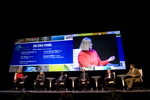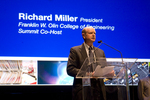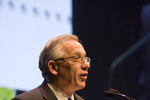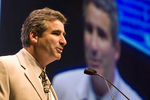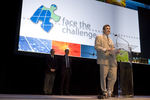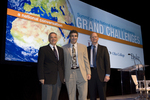- 2013 Research Triangle Park Summit
- 2013 Global Summit - London
- 2010 National Summit - Los Angeles
- 2010 Seattle Summit
- 2010 Chicago Summit
- 2010 Boston Summit
- 2010 Phoenix Summit
- 2010 Raleigh Summit
- 2009 National Summit - Durham
- Plenary Talk - Charles Vest
- Session I: Energy and the Environment
- Session II: Health
- Session III: Entrepreneurship
- Session IV: Security
- Session V: National Survey Findings
- Session VI: Understanding the Brain: Learning and Computation
- Session VII: Big Idea Panel
- Video/Essay Winners
- Speaker & Panelist Bios
- Poster Contest Winners
- Organizing Committee
- Summit Sponsors
- National Survey Results
- Grand Challenge Scholars Program
- Grand Challenge K12 Partners Program
Session VII: Big Idea Panel
Session Photos
Session Summary
Moderator: Moira Gunn, host, TechNation NPR
Panel Discussion: Louis Martin-Vega, dean, North Carolina State University; Leah Jamieson, dean of engineering, Purdue University; Richard Miller, president, Olin College of Engineering; Tom Byers, professor, Stanford University; and Ilesanmi Adesida, dean, University of Illinois.
The final panel discussion of the Grand Challenges Summit was devoted to sharing “big ideas” related to engineering and engineering education. The panelists defined “big ideas” as a transformative, inspirational, and compelling idea that change people’s lives and the world on a large scale.
Louis Martin-Vega, dean of the College of Engineering at North Carolina State University, said the world needs transformative technology to solve the 14 grand challenges—and soon. He said there’s no silver bullet, but asked, “Is there a silver portfolio we should be working toward? We really need a lot of very quick big ideas.”
To generate the silver portfolio, the panelists agreed, it’s critical to not only attract the best and the brightest young people to engineering, but to teach engineering students a wider range of skills.
“The grand challenges represent the challenges of the future; they belong principally to our students,” said Rick Miller, president of the Franklin W. Olin College of Engineering, “Only about 5 percent of our youth graduate in engineering-related fields.” Unless that changes, he said, it will be much harder for society to solve the grand challenges.
Leah Jamieson, the John A. Edwardson Dean of the College of Engineering at Purdue and Ransburg Distinguished Professor of electrical and computer engineering, suggested introducing engineering in the K-12 curriculum and working to attract more girls, African-Americans, and Latinos to engineering. She also suggested making university education more experiential with students working on original projects from day one and gaining real-world experience in co-ops, internships, in-service, and learning communities.
Tom Byers, professor at Stanford University, wants students to learn to become job generators, not job seekers. “By being designers, you end up designing something that becomes commercialized and you create jobs.”
Byers also said entrepreneurship needs to be taught in engineering schools: “In order for breakthroughs to be accelerated into the world, we need entrepreneurial thinking. It can be taught; it can be learned.”
Moderator Moira Gunn, host of TechNation and BioTech Nation, asked the audience to share their big ideas. Students and others immediately began stepping up to the microphones. The big ideas shared were all over the map, from technological (“Can we develop roads to capture solar energy and transfer it directly to cars?”) to educational (“Let’s encourage engineering students to be artistic and abstract as well as linear”) to societal (“We need to integrate universities, engineers, government, industry, and business”) to philosophical (“If we meet these 14 challenges, then our population could go to 20 billion, creating a new set of challenges. When do we think about engineering the equilibrium?”).
As the audience talked and panelists responded, a consensus emerged that today’s engineering students need to learn not just engineering, but also business, public policy, law, ethics, and human behavior.
Ilesanmi Adesida, dean of the College of Engineering at the University of Illinois, Urbana-Champaign, said, “We like to think of engineering as the new liberal arts.”
To wrap up the panel, Rick Miller introduced a big idea called the Grand Challenge Scholars, which is a curriculum developed by Olin College of Engineering, Duke’s Pratt School of Engineering, and the University of Southern California Viterbi School of Engineering. The program has five components: research related to one of the grand challenges, interdisciplinary coursework, entrepreneurship, global perspective, and service learning. Students who complete the curricular and extra-curricular aspects of the program will become Grand Challenge Scholars.
“We need to change the way we educate engineers—we need to produce young minds that are comfortable integrating and seeing themselves as leaders,” Miller said. “We hope others will join us. We hope each of you will consider establishing a Grand Challenge Scholars group on your campus.”
After Miller spoke, the deans from USC Viterbi and the Duke Pratt engineering schools each gave some concluding remarks.
Yannis Yortsos, dean of Viterbi, said, “This first Grand Challenge Summit was intended to light a fire to the growing enthusiasm [around the challenges]. The torch was lit and it will surely spread over the country.”
Yortsos said he hopes there will be another Grand Challenges Summit in a year or two.
Tom Katsouleas, dean of the Pratt School of Engineering at Duke University, said, “This has been a great start to the conversation. Let’s continue it in the classrooms, in the hall, in the media, in Congress, and around the corporate water cooler. Together we can face the challenges.”
Summit TopicsSummit SpeakersSpeaker InterviewsSpeaker Topics




